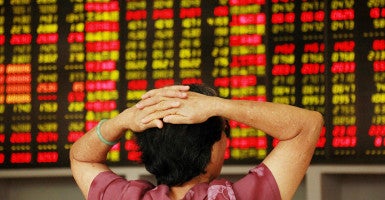In mid-June, China’s Shanghai Composite Index was up a dazzling 60 percent since the beginning of the year. It was the highest level in more than six years. Some took it as a sign that the recent weakness in China’s economy would be short-lived.
Yet it is only a little more than two months later, and the index had lost all its gains since the first of the year.
Many small domestic investors who had entered the market late were burned. Badly.
From 2008 through the end of 2014, China breezed through the global economic crisis and its aftermath with annualized growth of 8.8 percent.
Meanwhile, in the U.S., annual growth averaged a paltry 1.2 percent.
Unfortunately for Beijing, its growth came at an enormous cost. Over this seven-year span, China went on the mother of all credit binges: Total household, corporate, and government debt increased fourfold to $28 trillion. Total debt now exceeds 250 percent of GDP, and even corporate debt runs in excess of 100 percent of GDP.
Should the global markets—and China’s market, in particular—be concerned?
The short answer is yes.
Here’s why:
- China is the world’s second largest economy, as well as the second largest importer.
- It is the largest trading nation for 75 countries and is by far the largest importer of commodities in the world, a vital export for many emerging market nations.
- Over the past seven years, China has accounted for an incredible one-third of global growth.
For the past three decades, China’s economic model was built on three pillars—exports, the property market, and domestic fixed-asset investment.
Unfortunately, these three pillars are now quite clearly crumbling.
The current account surplus (a broad measure of the trade balance) shrank from 10 percent of GDP in 2009 to just 2.1 percent in 2014.
Contrary to conventional wisdom, exports have not been a significant source of Chinese growth since 2008.
The housing market, a critical recipient of household savings and an economic engine, is purported by some developers to have a glut of 70 million unsold homes.
In most major cities, residential prices have been falling for 18 months.
Then there is domestic investment. Until quite recently, it has been running close to an astonishing 50 percent of GDP but producing only 5 percent top-line growth (higher than official figures but likely closer to actually growth).
This implies that the return on invested capital is rapidly dropping.
Other signs of a slowing economy abound.
Many basic industries, such as steel and cement, are operating at 75 percent capacity or less, and factory prices have been declining for three consecutive years.
This brings us to the recent Chinese stock market collapse.
The benchmark Shanghai Composite stock index (Asia’s second largest after Japan) as of this past week fell almost 50 percent since its recent peak.
Over the past 20 years, little correlation stands between economic growth in China and the performance of its stock market.
This pattern appears to be reversing as investors increasingly believe that the state capitalist model that Beijing began adopting a decade ago is simply not working.
The uneasy fact is that Beijing is trapped in a Catch-22. It could once again replicate its enormous bailout package from 2008 and pump up infrastructure spending and short-term growth. This would only increase already dangerous debt levels and put off the day of reckoning—that is, a very hard landing.
Its second option is to move on its promise to “rebalance” the economy away from fixed-asset investment toward a consumer-driven society. But China has been hooked on cheap credit for a long time. This deleveraging process would likely produce a financial and economic crisis, similar to what the U.S. and Europe have gone through as they deleveraged.
On top of that, Chinese households would likely hunker down during a period of economic contraction and job losses, making the transition protracted and difficult.
Which path will Beijing choose? Fearing slowing growth, the central government recently backed away from reining in borrowing by local governments and, once again, boosted infrastructure spending. The central bank has cut interest rates five times since November, and the renminbi has recently been devalued.
At least for now, it looks as though China has chosen to put off the day of reckoning.
Originally published in Investor’s Business Daily.































